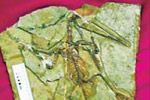Photos
Crystal Chinese Liuli
Updated: 2010-06-30 11:54
By Qu Ran (chinaculture.org)
We hear the word Liuli (Chinese traditional colored glaze) very often. But what is Liuli? How did it come into being?
Liuli is one firing material exclusively used by ancient Chinese royal families, which dates back to the West Zhou Dynasty and East Han Dynasty 3,000 years ago. The user of Liuli was strictly confined so it was seldom seen among the common people.
Chinese Liuli has a long history. It is said that Liuli was first accidentally discovered by an alchemist named Lu Shen when refining the Elixir of Life for the emperor. He presented those clear radiant objects in the furnace to the emperor, claiming them to be the very medicine with functions of exorcising and maintaining life indefinitely. The emperor was so impressed and from then on the production of Liuli began.
| Chu Kuo Jade, the Warring States Period |
In Xi’an light green color Liuli beads dating to the West Zhou Dynasty were unearthed. During Wei, Jin, South and North Dynasties, with the prevalence of Buddhism Liuli was used in the production of bowls, cases of inkstones, folding screens and a large number of adornments on Buddha statues. With more varieties coming out, Liuli started to be used as decorations on doors and windows during the Sui and Tang Dynasty and later in women’s accessories. Site of Liuli furnace from late Yuan Dynasty have been unearthed in Mountain Bo Shan, Shan Dong Province. In the Ming Dynasty Liuli workshop was also set up in Mountain Bo Shan. Liuli produced in Kun Ming and Yong Chang were very well-known at that time too, with black, white, red, bright orange or green colors and were mainly in shape of chess pieces.
| Liuli Banana Leaf Plate in Pagoda of Ashoka king |
During the reign of Emperor Kangxi in Qing Dynast(1662~1722), Liuli plants were established, producing cups, bowls, bottles, plates and snuff boxes with more than 10 colors of transparency, ivory, cream, snow, pink, red, blue, purple, yellow, green and gold. Till the reign of Emperor Qianlong, the figure reached more than twenty. At that time, the use of Liuli, especially its specific color indicating rigid hierarchy, was strictly confined. Yellow exclusively used for emperors therefore yellow Liuli tiles could only be used on the imperial architectures. The roofs of princes’ palaces were built with green Liuli tiles and commoners were not allowed to use Liuli tiles.
 |
| Liuli Pixie, modern craftwork |
Liuli artwork is what we call the product made of Liuli. With bright colors, vivid shape and delicate design, it is favored by people from all over the world.
The raw materials of glassware are silicates and its metallic oxides which abundantly exist in nature. After melting under high temperature they are made into sticks of different sizes and then softened on light before being handmade into final products. Unlike glaze, Liuli artwork has no mould, each one being unique as craftsmen’s improvised work. In comparison with glass, Liuli artwork has a lower melting point thus making it more colorful. Perfect glassware comes from not only good skills but also luck.
Specials

President Hu visits the US
President Hu Jintao is on a state visit to the US from Jan 18 to 21.

Ancient life
The discovery of the fossile of a female pterosaur nicknamed as Mrs T and her un-laid egg are shedding new light on ancient mysteries.

Economic Figures
China's GDP growth jumped 10.3 percent year-on-year in 2010, boosted by a faster-than-expected 9.8 percent expansion in the fourth quarter.


